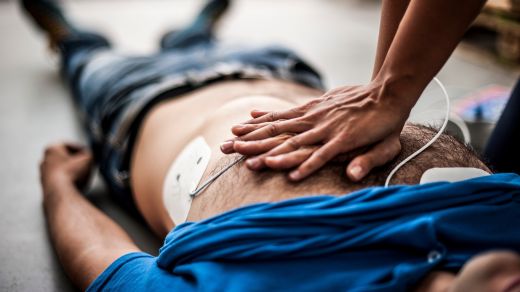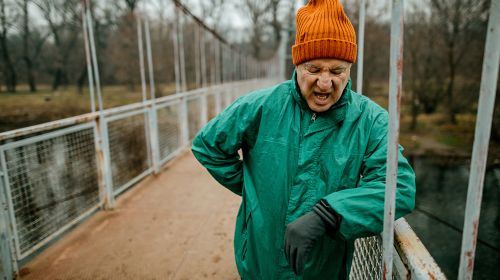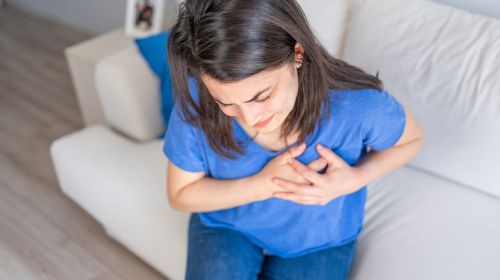From one second to the next the heart begins to beat irregularly, cardiac fibrillation occurs and then cardiac arrest. Sudden cardiac death also affects young people, athletic people and those who were previously healthy. What’s behind the second death and how to act correctly.
- © pixelaway – stock.adobe.com
Quick overview: Sudden cardiac death
Definition: Sudden cardiac death means that a person dies unexpectedly and very quickly. This is a medical emergency.
Causes: There are often heart diseases that trigger sudden cardiac death. Causes outside the heart, such as a pulmonary embolism, are also possible.
Symptoms: Initially there is often malaise and cardiac arrhythmias, followed by severe chest pain and shortness of breath.
Therapy: Call the emergency number immediately, then provide first aid with chest compressions and ventilation (if necessary). If accessible, a defibrillator can also be used.
Article contents at a glance:
What does sudden cardiac death mean?
Sudden cardiac death refers to deaths in which a person dies very quickly and unexpectedly due to acute heart failure. Younger people can be affected just as much as older people.
In the case of instant death, the heart function suddenly fails – usually no more than an hour passes from the first appearance of symptoms to death if resuscitation measures are not started immediately.
Sudden cardiac death: Symptoms resemble heart attack
Sudden cardiac death usually begins with a change in the normal heart rhythm, with the heartbeat of the main chambers accelerating significantly (tachycardia). If the heart beats faster and faster, enough blood can no longer be pumped into the body.
What is characteristic of sudden cardiac death is that the event occurs very quickly. As a rule, there are hardly any warning signs or early symptoms. However, if symptoms similar to a heart attack are noticeable, they should definitely be taken seriously:
- massive chest pain
- severe tightness
- Shortness of breath
- heart racing
- heart palpitations
- dizziness
- unconsciousness
Those affected collapse and are usually no longer responsive. The pulse in the carotid artery can no longer be felt, and shortly afterwards breathing stops. Death can occur after just a few minutes. Only immediate first aid increases the chances of survival.
Causes of sudden cardiac death
Due to the cardiac arrhythmia, the organ is no longer adequately supplied with blood and the contraction of the heart chambers becomes increasingly shallow until cardiac fibrillation (ventricular fibrillation) ultimately occurs and thus practically leads to cardiac arrest. This condition is life-threatening because the body’s organs are no longer supplied with oxygen and nutrients when blood is not pumped throughout the body.
Heart disease is often the cause:
Coronary artery diseases such as coronary heart disease (CHD)
Cardiomyopathies such as inflammation of the heart muscle (myocarditis)
Cardiac arrhythmias
heart failure
Heart valve disease
congenital heart defects
The causes can also lie outside the heart. For example, a massive pulmonary embolism or a rupture of the main artery (aorta) can cause sudden cardiac arrest.
Around five percent of all cases of sudden cardiac death occur in people who are considered to have completely healthy hearts.
Sudden cardiac death while exercising
Sometimes young, physically active people are also affected by heart disease. The trigger is often a previously unknown heart disease such as a congenital heart defect. However, acquired heart disease can also be the cause of sudden cardiac death in athletes. In younger people it is often an infectious myocarditis, while in older people it is more likely to be due to unknown coronary heart disease.
Diagnosis of sudden cardiac death
Experts make the diagnosis based on the characteristic signs of acute cardiac arrest:
- unconsciousness
- Pulselessness
- Apnea
If an emergency doctor is on site in time or if those affected are taken to the clinic immediately, further examinations can be carried out.
Ventricular fibrillation is clearly visible on the ECG. In addition, cardiological tests help with the diagnosis and show what physical causes could exist for sudden cardiac death. These include blood tests, cardiac catheterization and electrophysiological examination (EPU).
Sudden cardiac death: how to treat it?
If a sudden cardiac death occurs, the patient’s final death can only be averted through rapid therapy and, if necessary, immediate resuscitation. If a sudden cardiac death is suspected, emergency services must be called immediately. As a result of the immediate measures, around five to eight percent of those affected survive. If expert helpers are nearby, more than 50 percent of people survive sudden cardiac death.
Until the ambulance arrives, immediate life-saving measures are necessary to maintain circulation and thus the oxygen supply as much as possible. In order to check whether those affected are still breathing or not, the head must be stretched backwards and the lower jaw pulled forward.
If breathing can no longer be detected, cardiac massage must be performed. To do this, the German Heart Foundation recommends pressing the sternum deeply (maximum 6 centimeters) and quickly (100-120 times per minute) towards the spine with stretched arms. If you feel safe, you can also provide ventilation. Otherwise, helpers should focus on chest compressions until the emergency services arrive.
Medical treatment is also initially about preserving life. This usually requires treatment with a defibrillator as well as intubation and subsequent artificial ventilation.
Defibrillator
The defibrillator is a device that uses an electric shock to give the heart impulses to rhythmize or continue beating. To do this, electrodes are placed on the chest and activated. The electrical shock is directed inwards from the chest to the heart and is intended to make it beat again. Defibrillators can be found in many public places such as airports, train stations, department stores and sports facilities. They can be used by anyone as they are very easy to use.
If there is a known high risk of sudden cardiac death, the risk can be reduced by having an implantable defibrillator in the body. Using sensors, it automatically detects acute dangerous situations and immediately delivers electrical shocks to the heart to bring it back into the correct rhythm.
Can sudden cardiac death be prevented?
As a preventative measure, risk factors for heart disease should be avoided early on. These include:
If disorders have already developed, such as high blood pressure (hypertension), high cholesterol levels in the blood or diabetes mellitus, these must be treated consistently. Because they promote coronary heart disease and therefore potentially sudden cardiac death.
No unusual, overly demanding sporting stresses
Precautionary measures with regard to sudden cardiac death also include having your heart health checked by a doctor before taking up any unusual sporting activity.
It is also advisable to be careful when resuming physical exertion after infections such as a cold, flu or corona. Serious or delayed infections can damage the heart muscle and cause myocarditis.


